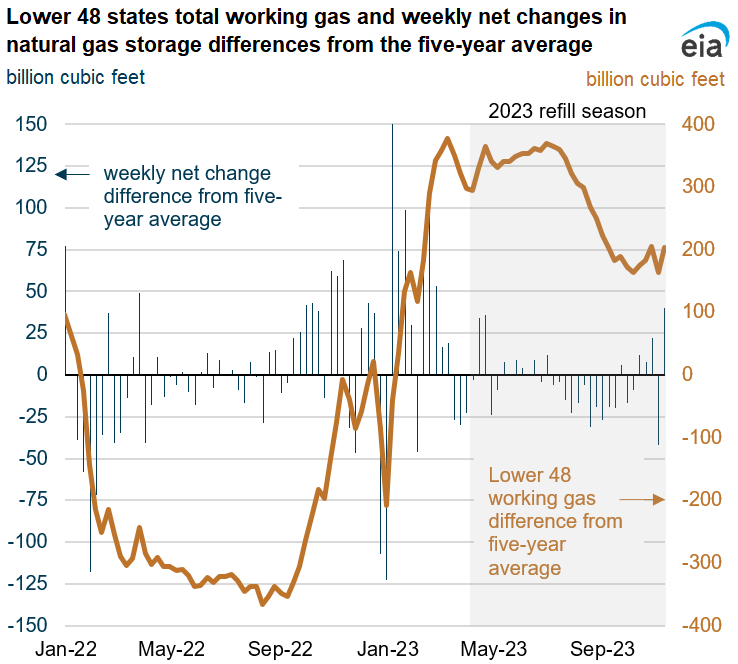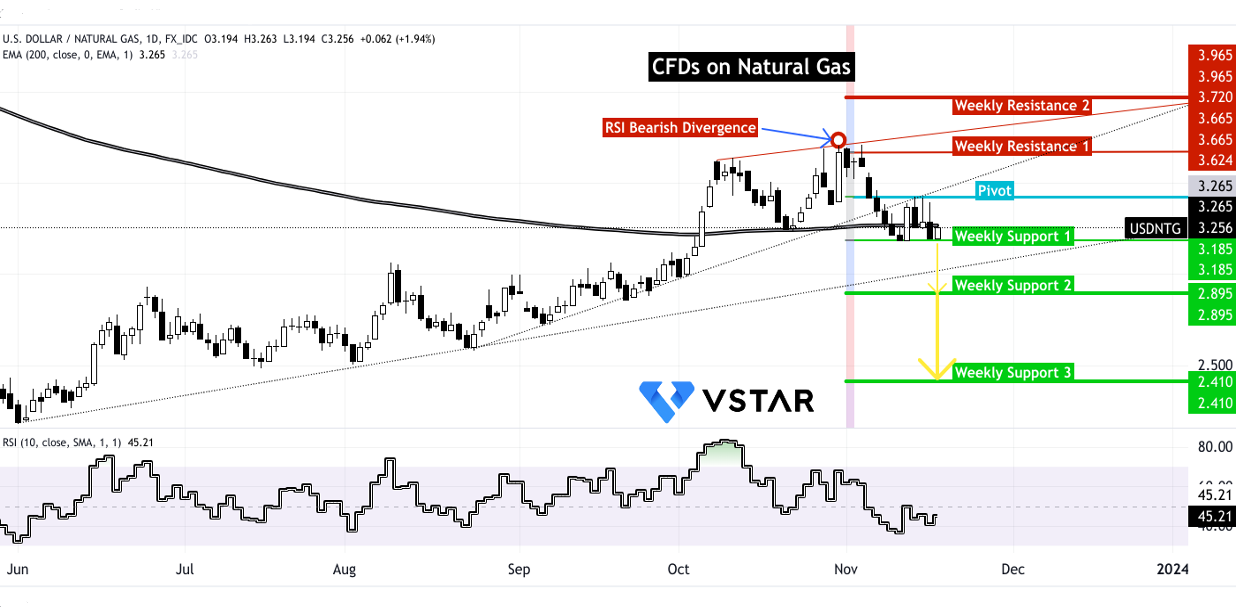- 根据最近的EIA数据,天然气库存超过历史平均水平,较5年平均水平增长5.6%。
- 生产、消费和出口的增加可能会平衡盈余,从而影响差价合约价格。
- 天气敏感性影响地区价格;寒冷时期会增加需求,影响价格动态。
- 不同的国际市场趋势暗示着不同的全球需求模式,从而影响国内天然气价格。
在动荡的能源市场领域,天然气差价合约是一个令人着迷的谜,受到影响其价格轨迹的无数因素的影响。从过剩库存的平衡到生产不断升级、需求激增和全球市场低语之间的微妙之舞,本文是穿越这一复杂景观的指南针。本文探讨了最近的《天然气周刊》 更新 由美国能源情报署发起,旨在揭示天气变化无常、错综复杂的供需平衡以及隐藏在国际市场趋势中的明显迹象的近期影响,解读天然气差价合约价格的过山车之旅。
天然气储存动态
库存水平和趋势
截至 2023 年 10 月 11 日,美国本土 48 个州的工作天然气总库存为 3,833 Bcf,比 5 年平均值 3,630 Bcf 增加了 5.6%,比去年的库存 3,635 Bcf 增加了 5.4%。
对补充季节(2023 年 4 月 1 日至 10 月 31 日)的审查显示,净注入量为 1,953 Bcf,比五年平均水平减少 5%,比上一年注入量减少 9%,表明库存积累速度较慢,尽管超过了历史水平平均值。

资料来源:eia.gov
影响:
库存过剩虽然低于历史平均水平,但表明供应缓冲充足。由于对存储容量限制和潜在供应过剩的担忧,这种盈余可能会对差价合约价格造成下行压力。
供需平衡
2023 年补充季节期间,美国干天然气产量平均增长 3%,达到平均 103.8 Bcf/d,而消费量也相应增长 3%。值得注意的是,电力部门用电量大幅增长6%,工业需求小幅增长近1%。此外,天然气出口(包括液化天然气和管道出口)大幅增长,其中液化天然气出口猛增15%,管道出口增长8%。
影响:
尽管产量增加,但各部门消费的激增和出口的增加可能会抵消库存过剩。如果需求超过供应,这种供需之间的平衡可以稳定价格或刺激价格上涨。
市场亮点和价格走势
现货价格和地区差异
亨利中心现货价格从 2.21 美元/MMBtu 飙升至 2.87 美元/MMBtu,反映出强劲的上涨趋势。类似的趋势也反映在区域现货价格上,特别是在东北部和西部等寒冷地区,取暖需求的增加推动价格上涨。
影响:
基于天气条件的地区定价差异凸显了天然气需求对温度波动的敏感性。持续的寒流可能会增加需求,从而影响价格走势。
国际期货价格
国际期货价格走势分化:东亚液化天然气货运价格下跌,荷兰TTF价格上涨。这些变化标志着全球市场不同的需求动态。
影响:
国际市场的对比趋势表明全球需求格局的变化可以显着影响差价合约价格的走向,特别是考虑到全球市场动态在塑造国内定价方面的作用。
钻机数量、存储趋势和市场情绪
钻机数量稳定性
尽管海恩斯维尔和马塞勒斯等特定地区存在波动,但天然气钻机数量保持不变,仍为 118 座,这表明生产活动保持稳定。

资料来源:eia.gov
影响:
稳定的钻机数量可能暗示着稳定的生产水平,但区域波动可能会对供应产生局部影响,从而影响区域价格动态。
存储趋势和市场情绪
尽管超过历史平均水平,但持续的净注入存储意味着持续的盈余。这种积累可能会影响市场情绪,由于对供应过剩的担忧,可能会导致前景看跌。
影响:
虽然过剩的存储可能暗示看跌情绪,但供需之间的平衡、天气敏感性和国际市场变化可能会抵消这些情绪。
对天然气差价合约价格的可能影响(关注价格方向)
看涨因素
- 需求增加:因天气寒冷而增加的消费可能会维持或进一步增加对天然气的需求,从而带来价格上行压力。
- 净注入量减少:尽管库存充足,但补充季节期间储备积累速度较慢可能会抑制供应增长,从而可能在短期内支撑更高的价格。
- 全球趋势:国际市场的走势和液化天然气出口的增长表明全球需求轨迹可能对天然气价格产生积极影响。
看跌因素
- 高库存水平:尽管净注入量减少,但总体库存仍大大高于历史平均水平,表明供应过剩。这种盈余可能会对价格造成下行压力。
- 产量增长:天然气产量的持续增长可能会导致供应过剩,从而可能通过进一步饱和市场来压低价格。
- 季节性变化:从注入季节到退出季节的过渡通常会导致市场波动加剧,可能导致价格波动,从而对投资者情绪产生负面影响。
天然气差价合约的技术分析
天然气差价合约价格在 10 月底失去了看涨势头,相对强弱指数 (RSI) 显示出看跌背离。尽管在 3.185 美元附近找到支撑,但 RSI 水平并未表明超卖情况(低于 30),这意味着差价合约价格可能进一步下跌。同一方向有可能达到 2.895 美元,其中 2.410 美元是波动剧烈的日子里的关键支撑位。
向上看,显着阻力位于 3.665 美元和 3.965 美元。然而,由于 200 天指数移动平均线 (EMA) 充当动态阻力,收盘价达到枢轴点 3.425 美元上方的可能性似乎较小。这种情况表明下降轨迹的可能性更高(由黄色路径表示)。此外,这一观点与美国国家海洋和大气管理局的预测一致,即美国冬季将比预期温暖,这可能在未来几周内对天然气价格施加额外的下行压力。

资料来源:tradingview.com
从本质上讲,供需基本面、天气依赖性、全球市场变化、投资者情绪和外部因素之间的多方面相互作用形成了复杂的挂毯,决定了天然气差价合约的轨迹。虽然库存过剩可能暗示看跌情绪,但供需之间的平衡,再加上天气敏感性和国际市场动态,将在这个复杂多变的市场格局中关键决定价格走向。

















